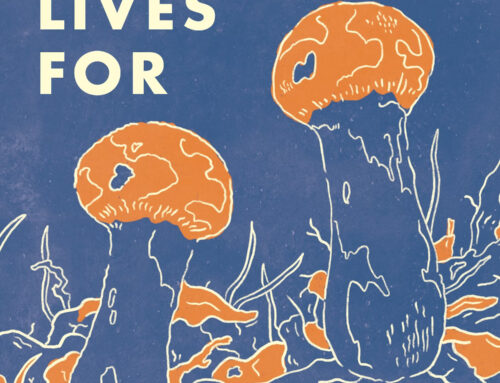by Bryan Dougan
Bryan Dougan, AES editorial intern and graduate student at the University of North Carolina, interviews Jon Bialecki, honorary fellow at the School of Social and Political Science at the University of Edinburgh about his prize-winning book A Diagram for Fire.
The conversation explores Pentecostal Christianity, assessing the quality and value of miracles, signs from God in contemporary U.S. politics, and Bialecki’s new research on Mormon transhumanism.

Bryan Dougan (BD): Jon, thank you so much for taking some time to answer a few questions about your work. One of the themes you repeat is that you’re trying to investigate what makes the Vineyard church different. Without giving away too much, what makes the Vineyard different to other forms of Christianity? Are there any ways you see it as similar to other forms of Christianity? And how might these similarities and differences relate to your central argument over the nature of religion?Jon Bialecki (JB): Well, the issue of difference also presumes some kind of commonality against which difference is made visible. But putting that bromide aside, the search for what is different about the Vineyard is also paradoxically a search for a way of thinking through what it is that the Vineyard shares with other Christian collectivities. To explain why this is the case, though, it helps to say a little bit about the Vineyard, the group that stands at the center of my ethnography. The Vineyard is a Southern California originated, but now worldwide, evangelical religious movement with more than two thousand four hundred churches across the globe. It has a strong sense of identity, and is known both for its lively style of worship (it was one of the first wave of Christian groups to pioneer the use of rock- and pop-sounding ‘praise songs’ instead of hymns) and for its purposeful, and sometimes outright pedagogical, promulgation of Pentecostal-style supernatural activity, such as speaking in tongues, prophecy, healing, and deliverance from demons. Further, there is a particularly ‘Vineyard’ style about the way that these Pentecostal ‘gifts’ (as they are frequently referred to) are expressed. They have a particularly egalitarian and informal edge to these spiritual practices, for instance.
Despite these commonalities, the wide distribution of the Vineyard, and the natural tendency of these churches to reflect aspects of the communities in which they are imbedded, means that there is also a high degree of internal variance. There are Vineyards that are rather politically conservative, but also that are deeply progressive (though not necessarily unthinkingly mirroring the politics of secular progressive movements). There are Vineyards where the supernatural is the front and center of the church, and Vineyards where Pentecostal-style supernatural practices are not foregrounded at all.
And so the task of the book is to think how we could account for all this variation, within the Vineyard, as well as between the Vineyard and other similar forms of Christianity. In the end, I argue that difference here is not about addition or replacement of traits, but rather about different expressions of a specific relation of forces found in many ecstatic protestant and post-protestant Christianities; and while the nature, origin, and intensity of the constituent forces varies from moment to moment, the fact that there is an underlying relation means that all these expressions still retain some recognizable patterning despite how unlike they may be from one another. And as you note, in the end I suggest that this mode of thinking through difference, and also of thinking through the different kinds of materiality that different differences allow, enables us to imagine a way of speaking about religion comparatively that doesn’t avoid the problem of religion being arrayed in very specific and non-universal ways at particular locales and at particular historical moments, but rather is predicated on such difference.
BD: One of the things I found interesting was your discussion about political economy and value in relationship to the Vineyard. How do you think political economy and value relates to the interpretation and understanding of miracles?
JB: It might be better to ask how does value and political economy relate to the miracle, and how does the miracle relate to political economy and value, as these are two distinguishable relations that rise to the surface at different moments, and which operate to multiple, distinguishable effects.
Value acts as a constraint on the miracle, or to put it more particularly, the miracle is constrained by valuing ‘quality.’ This is because in the Southern California culture where I did my fieldwork, quality is understood as the reliance on certain techniques and aesthetics derived from marketing; this makes it appear that churches are presenting themselves in the way that brands are put forward. This fact can lead to a misunderstanding. Churches do not necessarily take that form for pecuniary reasons (most pastors make little more than a public school teacher does) but rather because ‘showing that you care’ means ‘acting like a professional.’ And ‘acting like a professional’ means using the aesthetics of consumer capitalism. And this means vigilantly maintaining a certain level of almost commodity-like consistency, a consistency that acts as a drag on the miraculous, because the miracle always takes the form of an interruption, or a surprise. As for the second part of your question, we’ll get into the most direct effects of the miracle on political economy when we talk about contemporary religion in the United States. It’s enough to say now, though, that the miracle runs counter to careful calibration in that domain, as well.
The relation between care and the Pentecostal/charismatic miracle I’ve just outlined may sound Manichaean, with two forces pitted against each other: a kind of actuarial logic obsessed with consistency, versus an eruptive, event-based logic of miraculous novelty. It certainly plays out in a Manichaean mode most of the time. But this isn’t two forces acting against each other; it’s rather fluctuations in how forces are expressed in particular moments. This is because these two modes are actually just variants of one another. Both the miracle and the imperative to oversee one’s self with care are responses to a divine sign; the difference is the kind of temporality associated with sign, whether or not it is understood as a scriptural or traditional obligation rooted in a prior divine sign, or a contemporary eruption in the form of a contemporaneous, immanent divine communication. So this is another example of thinking about difference as being an effect of different qualitative intensities – in this case, qualitative intensities involving perceived temporality – into the same relation of forces to achieve quite different effects.
BD: I found your analysis of the “diagram of fire” as one that encompasses all parts of life — ethical, biological, pedagogical, to name a few — fascinating. One aspect that you discuss briefly in chapter 7 of the book is the political, but could you elaborate how using the “diagram of fire” might illuminate contemporary politics and religion in the US?
JB: I can only really gesture at an answer here, because a discussion of all the substantive forces in play, and all the various metaphorical and actual spaces where they might be expressed, is too large to enumerate. But to move quickly, the Pentecostal/charismatic diagram that I abstract out of the Vineyard, and which I claim organizes a sufficient portion of American Pentecostal and charismatic life in general, draws on affects and intensities normally associated with distinguishably different origins and capacities, such as the ones you listed here (the ethical, the biological, the pedagogical, etc). What is important is whether it produces something that is taken as a divine sign. As long as it produces a divine sign that a) is understood as breaking with the expected order of things, and b) demands a response from those to whom the sign is directed, it is a miracle – or at least for those who take it as such.
Just like the diagram can draw on different forces located in different ‘strata,’ it can be expressed in different ‘strata’ as well, including economic activity, and also in the political arena. This means that while political praxis is often times organized by certain assumptions and sensibilities, there are moments where there is some ‘event’ that is seen as so surprising – which is to say, as breaking with understandings of how the quotidian world operates – that it can only be received as a miracle that compels some sort of response. And while I hate to play the ‘why did Trump win’ game, and I certainly don’t want to say that class resentment, racial animus, foreign interference, and host of other factors didn’t also play a part in his winning the electoral college, I think that one reason that Trump captured the imagination of the vast majority of evangelical voters was because Trump was such an unlikely candidate, his nomination and eventual victory could only be a sign from God. As Franklin Graham, the conservative, evangelical inheritor of Billy Graham’s legacy, said on social media right after Trump was elected, “Did God show up? In watching the news after the election, the secular media kept asking ‘How did this happen?’ ‘What went wrong?’ ‘How did we miss this?’ Some are in shock. Political pundits are stunned. Many thought the Trump/Pence ticket didn’t have a chance. None of them understand the God-factor.” This “God-factor” could be understood to be the political power of the evangelical vote. But I also want to note that it can also be read simultaneously as God actively breaking into and acting upon the electoral process.
This possible conflation of the political and the miraculous isn’t something particular to the evangelical political right; the evangelical political left often speaks in similar ways, looking for some radical turn of events, something shockingly unexpected, and reading it as a sign from, or act of, God. Often these miracles that the evangelical left imagines are in the domain of the ethical, but all the same, they are drawn to moments that appear to be a break with the manner in which the world normally operates, breaks that are so sharp that they could only have been occasioned by a divine hand.
BD: One of the things that struck me reading your book is the way in which your body — the ethnographer’s body — is present in the text. This was particularly revealing when talking about prayer and healing. What are the strengths and weaknesses of this kind of embodied ethnography?
JB: I’m going to be blunt and say that I don’t see many dangers to embodied ethnography, other than the risk that there may be many moments where attending to the body may be irrelevant to the ethnographic task at hand. I don’t want to say that an attention to the body of the ethnographer is a privileged ethnographic tool in any way, of course; there are innumerable quite conceptual ethnographies out there that don’t truck with the body and work perfectly well on their own terms. That being said, the body, along with the rest of the sensorium, is an incredible recording surface, and as long as the ethnographer can find a way to both convey his or her findings, and make those findings adequate to a socially-oriented account of whatever the object of investigation is, I see no reason why embodied material shouldn’t be incorporated. Scholars as diverse as Charles Hirschkind and Thomas Csordas have used it to good effect, so I don’t feel that there is anything particularly epistemologically difficult here.
BD: Your work has appeared alongside that of theologians in special volumes (I’m thinking about Stanley Hauerwas and Catherine Pickstock in South Atlantic Quarterly). Certain circles of theology have had an “ethnographic turn.” How do you see the anthropology of religion and anthropology of Christianity being in dialogue with theologians both methodologically and theoretically? How do you hope they’ll receive your work?
JB: I have mixed feelings about any theological/anthropological rapprochement. On one hand, I think that engagement with theology is beneficial for all the reasons that Joel Robbins laid out in his classic Anthropological Quarterly article on the “awkward relationship” between anthropology and theology; theology can serve as a source of ethnographic evidence, as a lens through which otherwise invisible crypto-religious assumptions inside of anthropology can be made visible, and finally, as an instigation to thought for one another, a source of challenges (drawn from their own peculiar capacities and weaknesses) to which each discipline has to answer. That being said, both theology and anthropology have distinctive criteria for evidence, forms of reasoning, audiences, and modes of validation, and I worry that the incorporation of some theological material into anthropology would result in material that either literally doesn’t make sense, or is presented in such a way that makes ethnographic aims that are immune to any anthropological critique.
In the end, though, I would say that the anthropology of religion shares a deeper commonality with both theologians and those informants who engage with religion; or at least the anthropology of religion shares a deeper commonality when its ethnographic questions are well-formed. So while the two disciplines should feel free to strategically borrow from one another, and have ties that cannot be denied, individuals who wish to have theological discussions should have them in theology (I’ll leave it to the theologians to determine whether theology is a space where people can have anthropological discussions, though as you allude to in your question, it appears that theologians like Michael Banner are at least authorizing themselves to have ethnographic discussions).
As for how I expect theologians to take my book in particular? It’s hard to say. I hope that they don’t see it as being hostile to their project, nor as an attempt to squat on their property. The problem of variation and identity seem to not be problems that most theologians have taken up (though of course there are some exceptions). So perhaps it will challenge them to create theological accounts that depart from the same problem, and (hopefully) these accounts would look quite different from mine.
BD: What’s next for you?
JB: Well, in an age of increasing academic precarity, it’s hard to say. While I’m still affiliated with the University of Edinburgh as a fellow, for family reasons I’ve had to move back to the United States, meaning my institutional future is up in the air. As for research, though, I can say that for the last four years I have been working on ethnographically documenting religious transhumanism, and in particular on documenting the Mormon Transhumanist Association. Transhumanist is the anticipation that developments in technologies such as cryogenics, nanotechnology, genetics, bioengineering, and artificial intelligence will so change the nature of our ‘species being’ (as Marx would say) that we in effect would no longer be human. The focus on the Mormon Transhumanist Association is a result of its prominence in transhumanist and religion transhumanist circles; due to doctrinal fit and organizational genius is the Mormon Transhumanist Association is the oldest, the largest, and the most influential of religious transhumanist movements.
My hope is that this research on religious transhumanist will accomplish two things. First, it will open up discussions of American debates regarding religion and science, if due to no other reason than allowing us to have another formation that the mainline conversation on this issue can be compared to. My project also could also read as an investigation into the nature of religion; what is the difference that religion makes in the otherwise usually secular transhumanist project?
One reason why I’m excited about this project (apart from how fond I am of the members of the Mormon Transhumanist Association as people) is that I think anthropological discussions of transhumanism are due to quicken; Anya Bernstein, for instance, has an upcoming book on Russian Transhumanism, which in combination with some already existing scholarship by Abou Farman, should be enough to allow us to see what some of the contours of an anthropology of the transhuman might look like. Bringing the anthropology of technology into conversation with the religious and the cosmological can only be a good thing, at least from my point of view.
BD: Thank you very much! I look forward to seeing what comes next for you.
Cite as: Dougan, Bryan. 2018. “AE Interviews Jon Bialecki, winner of the Sharon Stephens Prize for his book A Diagram for Fire: Miracles and Variation in an American Charismatic Movement.” American Ethnologist website, April 9, 2018. http://americanethnologist.org/features/interviews/aes-interviews-jon-bialecki




